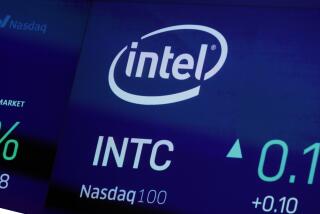Intel Sees Future in Memory Chips
- Share via
When Intel Corp. Chief Executive Craig Barrett is asked by his division managers for more resources, he calls them into a windowless conference room down the hall from his cubicle at the company’s Santa Clara, Calif., headquarters.
“It’s like being summoned to the principal’s office,” said Tom Lacey, who has been through three such meetings in the six months since he was named to run the company’s memory chip business. The unit had an 18% slump in sales in 2003.
Lacey, 46, said he passed what Intel employees refer to as “inquisitions,” winning Barrett’s approval to increase his engineering head count by 70% and spend more on research.
“The pressure is on us now,” Lacey said.
Barrett’s focus on Intel’s memory chips, which store data and programs in products such as mobile phones, has begun to pay off. According to data released last week by El Segundo-based ISuppli Corp., a technology research firm, Intel stemmed a decline in its share of the $11-billion market for memory chips during the first quarter.
“Intel is making the right start in diversifying to find other ways to drive growth,” said Sangeeth Peruri, an analyst at J. & W. Seligman in Palo Alto.
Intel, the world’s largest maker of semiconductors, said last month that the flash memory business, which accounted for 5.7% of total revenue last year, was the main reason the company might reach its highest sales forecast this quarter. The market for flash memory is growing more than twice as fast as Intel’s computer processor business.
Barrett told investors in May that communications and memory chips would jump-start orders, as sales growth is forecast to slow to 9% this year.
Intel had 10.3% of the flash memory market in the first quarter, little changed from the fourth quarter’s 10.6%, as industry sales rose 2.5% to $4 billion, ISuppli analyst Betsy Van Hees said. Intel had begun 2003 with a 19% share.
The company slumped last year to fourth from first in market share after customers balked at a decision by Lacey’s predecessor to raise prices. Barrett has charged Lacey with reclaiming Intel’s top ranking.
Sales of flash memory will grow about 49% this year, nearly three times the sales rate of other microprocessors, according to June forecasts by the San Jose-based Semiconductor Industry Assn., a trade group.
To become the market leader, Intel must surpass South Korea’s Samsung Electronics Co., Japan’s Toshiba Corp. and No. 3 Advanced Micro Devices Inc. Samsung and Toshiba gained last year in part because they made chips using a technology better suited for the memory cards that store pictures in digital cameras.
“We are working like crazy because we have some catching up to do,” Lacey said.






